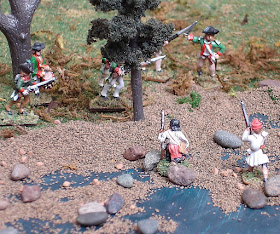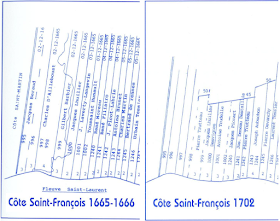This is the third of three posts on the October 30, 1775, battle of Longueuil. For the first two parts, see
here and
here.
On the morning of October 30, 1775, British forces in Montreal boarded boats in the harbor and set out to do battle with American forces on the other side of the St. Lawrence River. A larger vessel (probably the schooner Gaspé and probably with Governor Guy Carleton himself on board) led the way. There were around 34 boats in total, most of them small craft. Claude-Nicolas-Guillaume de Lorimier, commanded the Canadian militia from one small boat, which contained “two rudders, eight rowers and others ready to fire.”
 The Battle of Longueuil (click to enlarge). The numbers on the map correspond with the numbers below describing key events during the battle. The arrows indicate the approximate location of troop movements during the battle.
The Battle of Longueuil (click to enlarge). The numbers on the map correspond with the numbers below describing key events during the battle. The arrows indicate the approximate location of troop movements during the battle.
1. A little before noon, the small boats passed Île Ronde and became visible to the Americans. A crowd of civilians followed the boats and watched events from the northern shore.
2. The American forces were garrisoned at Longueuil on the southern shore. When the boats came into view, the troops marched down to the riverfront. They brought with them a recently arrived 4-pounder cannon. This functioned as a kind of secret weapon, which the soldiers hid by standing close around it.
3. The British boats did not make a direct descent on Longueuil. Instead, the schooner turned back upstream. The Americans dispatched a company-sized detachment to follow it. When the schooner neared the southern shore, the Americans began firing at it. The schooner then appeared to veer away, and the rest of the boats followed and “promenaded” past Longueuil.
When the British boats reached Île Ste Hélène, some of the Canadians and Native Americans disembarked. This group, under the command of de Lorimier’s brother (Jean-Claude-Chamilly) went down to the shallow water separating Île Ste Hélène from the southern shore. Meanwhile de Lorimier arranged the boats in a line of battle.
 American Continentals of the 2nd New York Regiment follow the British boats.
American Continentals of the 2nd New York Regiment follow the British boats.
4. More and more American infantry were sent upstream until only the 4-pounder gun and its crew were left in the village.
5. Carleton, however, did not immediately give the signal to attack (he was to fire two cannons). While de Lorimier waited, Chaptes La Corne Saint-Luc came alongside him in a canoe paddled by Algonquians. They were singing a war song. La Corne Saint-Luc was an experienced officer and part of Carleton’s inner circle. When de Lorimier asked him what was to be done, La Corne Saint-Luc pointed ahead and said “Voilà l'endroit où il faut se distinguer.” De Lorimier took this to be the general order, and at that moment, he recalled:
“I made the cry of attack - My brother, on the cry, rushed with all his Indians on the shoals to get to the mainland, from sandbar to sandbar and rock to rock…”
The boats then advanced “in line, all in the same order, all my boats on my left and to the right those Indians who might listen to my orders. We proceeded in that order.”
The Americans were now taking position on the southern shore opposite Île Ste Hélène. Many lay down behind the river bank, which formed in places a natural breastwork. Others crouched behind pine trees. Two Indians got to the shore as the Americans were deploying. One David Mallary of the Green Mountain Boys ran down and captured one. The other got away and hid in a barn (he was captured that night).
 The Green Mountain Boys take position before British forces can get to shore.
The Green Mountain Boys take position before British forces can get to shore.
Then the Americans opened fire as a number of Indians and Canadians neared shore. These men were horribly exposed, and they either ducked down behind rocks or took shelter on the small islands. They returned fire against an enemy they could barely see.
 The Green Mountain Boys, prone behind the river bank, fire on British forces in the river.
The Green Mountain Boys, prone behind the river bank, fire on British forces in the river.
Carleton was not pleased, and he soon gave the signal for the troops to withdraw. Some immediately fell back, but others found themselves pinned down close to shore. The boats did not uniformly respond either. De Lorimier was so focused on what lay ahead of him, that he initially missed the signal to retreat. When his boat did withdraw, he observed a boat containing some men of the 26th regiment that had gotten caught on the rocks. The men on board could not extricate themselves, and they lay down waiting for night to fall.
From out in the river, the British fired shot and shell on the Americans. None struck the well-protected Americans, although there were close calls. Lieutenant John Fassett of the Green Mountain Boys recalled, “There was one shell broke within a few feet of my head right over me. The pieces flew all around me and there were men lying very thick around me, but none received any harm.”
6. Carleton then ordered some of the boats to descend on the village, but when these boats neared shore, they were repulsed by the Americans’ cannon.
Sporadic musket fire continued along the shore. There, Fassett had another close call: “I had got my gun charged and was lying flat on my belly as all the rest were and was going to get up to see if I could see anybody to shoot at when one spoke and said: “There is a man running, shoot him!” I put my head a little higher when all at once our men fired very brisk and one that was behind me fired his gun over my head so that it seemed to shake my head, and Capt’n Stanton that was close behind me said that he expected I was killed. He said it did not go more than one inch from my head the whole charge, but it did not hurt me.”
The American infantry received some small reinforcements. Captain John Nicholson's company of the 3rd New York arrived from La Prairie. More importantly, the gun crew in Longueuil brought their cannon up river, and fired on some more boats and raked the small islands in the river.
By this time, Carleton had had enough, and he and his flotilla returned to Montreal. His last order was for “fires on the island [to be lit] to warm the Indians who might withdraw.”
According to Fassett:
“By this time it had begun to be dark. Then we hailed the Enemy (for there were some within 30 rods) and told them that if they would come ashore to us they could have good quarter, there were 3 behind one rock that said they would. We waited for them sometime. Then we called again. They said they had a wounded man they could not bring. Col. Warner [i.e., Lieutenant-Colonel Seth Warner] told them to leave him and come ashore and if they offered to run back, or if they fired a gun, Death was their portion. Then we see one stepping off the other way Col. Warner ordered us to fire. The gun cracked merrily at him. He fell down and crawled off, but whether we hit him I don’t know.”
The Vermonters then brought off the wounded man, a Mohawk that de Lorimier called, “my great chief Hotgouentagehte.” He was bleeding profusely from a leg wound, and he died soon after being brought on shore. The other man was Jean-Baptiste Lemoine dit Despins, who, according to Fassett, “was a gentleman… [whose] father is one of the richest men in Montreal.” Other men venturing out into the water took prisoner a militiaman named Lacoste.
The battle of Longueuil was a one-sided victory for the Americans. Captain Wait Hopkins of the Green Mountain Boys was slightly wounded. There were no other American casualties.
British casualties are uncertain. The Americans found two dead Native Americans after the battle (in addition to the Mohawk chief), and they captured two Native Americans and two Canadians. De Lorimier knew about the losses reported by the Americans, but he did not mention any other Canadian or Native American casualties. He did, however, state that there were two killed and three wounded in the stranded boat containing troops of the 26th regiment.
The Americans believed they inflicted heavy losses. According to Fassett, the Americans learned from a Canadian prisoner that “we killed 12 men in the first Boat that tried to land. They said they believed we killed 9 others and wounded about 50 men.” But where were the bodies? Either their deaths were imagined or the dead were carried away by the river. Their fire had certainly seemed devastating. During the battle, Fassett noted, “We saw numbers fall down and some never got up again.”
Fassett slept little that night, and the next day he witnessed the burial of the Native Americans:
“The 3 Indians were buried when we got there. Canadians were digging a grave for them. They dug it about 2 ft. and a half deep, then put them in stark naked with their faces downward, two at the bottom with their heads both one way, the other on top with his head at the others feet. Then they flung on dirt and then stones. ‘Twas such a funeral as I never saw before. Nothing extra, it is very cold.”
Note:
This account of the battle of Longueuil is constructed chiefly from the journal of John Fassett, and the memoirs of Guillaume de Lorimier and Simon Sanguinet (both published in Verreau's 1873 Invasion du Canada). Attention was also paid to brief descriptions of the battle appearing in a number of other places, such as this letter from Richard Montgomery to Philip Schuyler, and this letter from one of the men besieging Fort Saint-Jean.
Also helpful were the entries in the Dictionary of Canadian Biography on Claude-Nicolas-Guillaume de Lorimier, and Chaptes La Corne Saint-Luc.
 This map shows several places referred to in this post. A - Montreal (where the British troops assembled before the battle), B - Ruisseau Migeon (English: Migeon Creek), C - Original site of a house linked with Ethan Allen's capture, D - Ruisseau des Soeurs (English: Nun's Creek), later called Molson’s Creek.
This map shows several places referred to in this post. A - Montreal (where the British troops assembled before the battle), B - Ruisseau Migeon (English: Migeon Creek), C - Original site of a house linked with Ethan Allen's capture, D - Ruisseau des Soeurs (English: Nun's Creek), later called Molson’s Creek.  Louise-Amelie Panet-Berczy's (1839) depiction of the Longue-Pointe battlefield (click to enlarge).
Louise-Amelie Panet-Berczy's (1839) depiction of the Longue-Pointe battlefield (click to enlarge).















